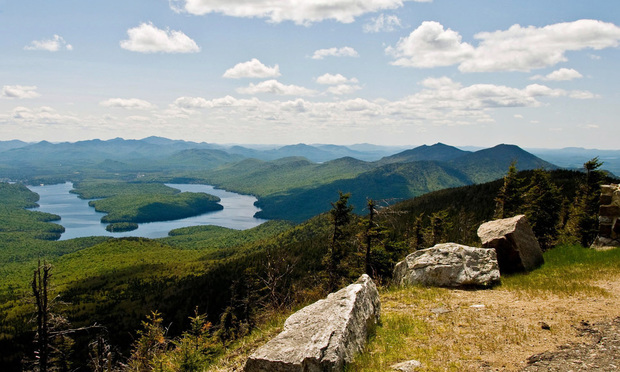NY High Court to Decide Future of One-Mile Stretch of Road in Adirondacks
A pair of environmental groups argued before the New York Court of Appeals that a section of state law, and a plan by a state agency, should inhibit public snowmobile use on the road.
September 05, 2019 at 04:07 PM
5 minute read
 A view of Lake Placid from Whiteface Mountain in the Adirondacks. Photo: Tony Fischer/flicker
A view of Lake Placid from Whiteface Mountain in the Adirondacks. Photo: Tony Fischer/flicker
A one-mile stretch of road in the Adirondacks was the subject of arguments Thursday before the state's highest court, which will decide whether that route can lawfully be opened for public snowmobile use after the state proposed a plan to do so three years ago.
A pair of environmental groups argued before the New York Court of Appeals that a section of state law, and a plan by a state agency, should inhibit public snowmobile use on the road.
The groups, Adirondack Wild and Protect the Adirondacks, were represented before the high court by Christopher Amato, an attorney with Earthjustice, a nonprofit environmental law group.
Part of the conflict presented to the Court of Appeals on Thursday was whether the road, which was previously owned by a paper company for more than a century, would be used more if the state opened it for public use, versus how it was used before.
That question was further complicated by the fact that the road runs through an area protected as "wild" under the state Wild, Scenic and Recreational Rivers System Act, or Rivers Act. The environmental groups had argued that the designation should prevent the state from opening the road for public snowmobile use.
The Adirondack Park State Land Master Plan, they argued, also barred the use of motorized vehicles in wilderness areas regardless of how it was used before.
"The Rivers Act specifically prohibits the use of motor vehicles in wild river areas, just as the Master Plan does," Amato said.
There is an exception to that rule, the state claimed. Assistant Solicitor General Laura Etlinger argued that state law allows the road to be opened for public use, as long as it's not altered or expanded.
Because the road had been used for commercial use for decades by the paper company, and recreational use by others, opening the route for public snowmobiling would not result in greater use, Etlinger argued.
"The question is whether it was rational, and the answer is they're going from 12 months of heavy use—commercially and recreationally—to a limited period of use and a limited type of vehicles," Etlinger said.
Amato argued that regardless of how the road was trafficked in the past, the state was expanding use of the route because it was previously closed off to the public for snowmobiling. That was allowed for private individuals, but not anyone else.
"This is absolutely an expansion of use, because previously snowmobiling was limited to the landowner, its contractors," Amato said.
He also argued that the road's previous use may not even apply because of what they've perceived as a conflict between the Rivers Act and the Master Plan. The Rivers Act includes an exception for previous use, Amato said, but also directs the state to follow any other rules that require a more restrictive use of land.
In this case, he argued, the Master Plan should supersede that exception because it's more restrictive.
"Here, the most restrictive provision as it exists in the Rivers Act and the Master plan specifically prohibits motorized vehicles in wild river areas," Amato said.
The state has taken the position that there is no conflict to analyze between the Rivers Act and the Master Plan, instead saying that the latter regulation recognizes that the state Department of Environmental Conservation has authority independent of it to regulate the use of wild areas.
"When there's something in the Master Plan that addresses what would also be in the Rivers Act, DEC has primary authority under the Rivers Act," Etlinger said.
Associate Judge Eugene Fahey, during arguments, opined on how the Adirondacks are uniquely situated as a "crown jewel" of New York, and should therefore be afforded close scrutiny by the court over the state's decision, regardless of how much land is in question.
Fahey was skeptical of how the state could quantify the use prior to opening the road for public snowmobile use, versus when it was in private hands.
"The question is, when you say it's open to the public … and this is not going to be an expansion, isn't it your burden to say it's not going to be an expansion by pointing to some quantifiable report?" Fahey asked.
Etlinger said there wasn't a date comparison, per se, but that the state Department of Environmental Conservation did not predict expanded use of the route.
"I think the record does support it," Etlinger said. "DEC, on that record, could rationally determine there would not be an expansion of use."
A decision in the case from the Court of Appeals will likely be handed down in October.
READ MORE:
NY State's Tree Cutting for Trails in Adirondacks Is Unconstitutional, Appellate Court Rules
Sex Abuse Case Presents Questions to High Court on Appellate Division, Special Prosecutor Powers
Court of Appeals Set to Review Alleged Class Action Rent Control Violations Against Building Owners
This content has been archived. It is available through our partners, LexisNexis® and Bloomberg Law.
To view this content, please continue to their sites.
Not a Lexis Subscriber?
Subscribe Now
Not a Bloomberg Law Subscriber?
Subscribe Now
NOT FOR REPRINT
© 2025 ALM Global, LLC, All Rights Reserved. Request academic re-use from www.copyright.com. All other uses, submit a request to [email protected]. For more information visit Asset & Logo Licensing.
You Might Like
View All


Prosecutors Ask Judge to Question Charlie Javice Lawyer Over Alleged Conflict
Trending Stories
Who Got The Work
J. Brugh Lower of Gibbons has entered an appearance for industrial equipment supplier Devco Corporation in a pending trademark infringement lawsuit. The suit, accusing the defendant of selling knock-off Graco products, was filed Dec. 18 in New Jersey District Court by Rivkin Radler on behalf of Graco Inc. and Graco Minnesota. The case, assigned to U.S. District Judge Zahid N. Quraishi, is 3:24-cv-11294, Graco Inc. et al v. Devco Corporation.
Who Got The Work
Rebecca Maller-Stein and Kent A. Yalowitz of Arnold & Porter Kaye Scholer have entered their appearances for Hanaco Venture Capital and its executives, Lior Prosor and David Frankel, in a pending securities lawsuit. The action, filed on Dec. 24 in New York Southern District Court by Zell, Aron & Co. on behalf of Goldeneye Advisors, accuses the defendants of negligently and fraudulently managing the plaintiff's $1 million investment. The case, assigned to U.S. District Judge Vernon S. Broderick, is 1:24-cv-09918, Goldeneye Advisors, LLC v. Hanaco Venture Capital, Ltd. et al.
Who Got The Work
Attorneys from A&O Shearman has stepped in as defense counsel for Toronto-Dominion Bank and other defendants in a pending securities class action. The suit, filed Dec. 11 in New York Southern District Court by Bleichmar Fonti & Auld, accuses the defendants of concealing the bank's 'pervasive' deficiencies in regards to its compliance with the Bank Secrecy Act and the quality of its anti-money laundering controls. The case, assigned to U.S. District Judge Arun Subramanian, is 1:24-cv-09445, Gonzalez v. The Toronto-Dominion Bank et al.
Who Got The Work
Crown Castle International, a Pennsylvania company providing shared communications infrastructure, has turned to Luke D. Wolf of Gordon Rees Scully Mansukhani to fend off a pending breach-of-contract lawsuit. The court action, filed Nov. 25 in Michigan Eastern District Court by Hooper Hathaway PC on behalf of The Town Residences LLC, accuses Crown Castle of failing to transfer approximately $30,000 in utility payments from T-Mobile in breach of a roof-top lease and assignment agreement. The case, assigned to U.S. District Judge Susan K. Declercq, is 2:24-cv-13131, The Town Residences LLC v. T-Mobile US, Inc. et al.
Who Got The Work
Wilfred P. Coronato and Daniel M. Schwartz of McCarter & English have stepped in as defense counsel to Electrolux Home Products Inc. in a pending product liability lawsuit. The court action, filed Nov. 26 in New York Eastern District Court by Poulos Lopiccolo PC and Nagel Rice LLP on behalf of David Stern, alleges that the defendant's refrigerators’ drawers and shelving repeatedly break and fall apart within months after purchase. The case, assigned to U.S. District Judge Joan M. Azrack, is 2:24-cv-08204, Stern v. Electrolux Home Products, Inc.
Featured Firms
Law Offices of Gary Martin Hays & Associates, P.C.
(470) 294-1674
Law Offices of Mark E. Salomone
(857) 444-6468
Smith & Hassler
(713) 739-1250







